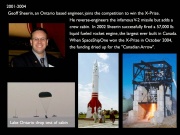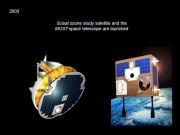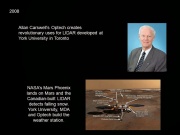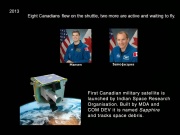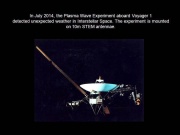100 Years of Aerospace History in Canada: From McCurdy to Hadfield Part 13 by Robert Godwin
From The Space Library
Geoff Sheerin and Space Tourism, our "Humble" Space Telescope, Emerson's Review and Snow on Mars
In January 2001, Geoff Sheerin, an Ontario based engineer, announced his plans to build a modern version of the infamous V-2 missile. Sheerin re-imagined the single-engine rocket as a vehicle for space tourism. Over the next three years his team worked around the clock to construct a viable entry in the X-Prize competition, which they named the "Canadian Arrow". Incredibly Sheerin also set about building his own rocket engine capable of boosting a passenger into sub-orbital space.
By July of 2002 Sheerin successfully fired a 57,000 lb. liquid fueled rocket engine, the largest ever built in Canada. In August of 2004 his team conducted a successful drop-test of their crew-cabin into the waters of Lake Ontario. Unfortunately when SpaceShipOne won the X-Prize in October 2004, the funding dried up for Canada's most ambitious attempt at a manned space program.
Despite the termination of Sheerin's noble efforts Canada's astronaut story continues onwards through the American space program with two more recruits added to the CSA team in 2009, David Saint-Jacques and Jeremy Hansen.
While they wait for the next generation of spacecraft to be built in the USA, Canadian space science continued onwards. Scisat, launched in 2003, was placed in orbit specifically to monitor stratospheric ozone levels, while MOST, a micro-satellite became Canada's first space telescope, looking up instead of down. Meanwhile, a device perfected at York University in Toronto discovered snow falling on Mars.
According to Dr Gordon Shepherd this particular success of Canadian technology begins at RCA in Montreal in the late 1960s. Allan Carswell left RCA to join the faculty at York University in Toronto. Carswell immediately applied his knowledge of lasers and microwaves to the burgeoning atmospheric science department at York; specifically he began to look at LIDAR as a possible candidate for studying atmospheric movements, density and disturbances.
As the team at York developed ever more sophisticated uses for LIDAR Carswell recognized a commercial opportunity and so in 1974 he formed a company he named Optech. This company rapidly grew into the leading LIDAR company in the world. In 1999 the Jet Propulsion Laboratory approached Optech to provide a LIDAR instrument for one of their proposed Mars landers. Over the next few years the involvement of Canadians in what would become Mars Phoenix, expanded rapidly, despite some ups and downs caused by the loss of an earlier Mars mission. By 2001 Optech and York University worked studiously on developing both the technology and the proposals for sending a Canadian LIDAR weather station to Mars.
In the summer of 2003 the University of Arizona's Peter Smith received news that his Phoenix mission would go ahead. It would be launched in 2007 and in September 2008, shortly after landing on Mars, the LIDAR would record the falling of snow on another planet.[i]
Although the media had some fun with the idea of Canadians being the first to discover snowfall on another world, as can be seen by the preceding short history, there was an inevitability about this. Canada is the home of the world's leading space weather researchers. Canada's space program, from the very beginning has been concerned with the environment.
In November 2012 a federally appointed commission on Canada's space future delivered their results to the government. In stark contrast to the Chapman Report, which had concentrated on the programs at hand and had steered Canada's official space program for 45 years, the Emerson Commission's report concentrated on policy. The eight recommendations in the executive summary made no mention of any specific program or hardware.[ii] The days of giant cannons and isolated rocket research centers are a thing of the past, replaced by budgets, advisory councils and the politics of international competition.
In 2013 MacDonald Dettwiler (MDA) and COM DEV International (COM DEV) teamed up with the Canadian Air Force to build the first Canadian military satellite, named Sapphire. Designed to monitor and track space debris it was also the first major Canadian spacecraft to be launched by the Indian Space Research Organisation.
In February 2014 the government of Canada announced that it would provide more funding to the CSA, but with the proviso that more of Canada's space efforts be undertaken by the private sector. This announcement was met with cautious optimism by the official opposition spokesman, Dr Marc Garneau. The future of Canada's space program continues to be as unpredictable as that of its southern neighbor. Not surprisingly the relationship with the United States continues to spur boisterous debate in Canada. As a final footnote to this story, on July 7th 2014 scientists at the Jet Propulsion Laboratory in Pasadena issued a press release that the Voyager 1 spacecraft, launched in 1977, had encountered a series of tsunami-like waves of plasma on the edge of the heliosphere.
This phenomenon was detected by the Plasma Wave experiment (PWA) installed aboard the spacecraft. The PWA operates by studying the plasma around the spacecraft using two 1¼ cm diameter by 10m long STEM antennae installed on the spacecraft in 1975. [iii]
It seems a fitting conclusion that over eight decades after Balfour Currie travelled into one of the most inhospitable places on Earth to study the weather, that the most distant place that man-made machinery has ever traveled is discovering unforeseen weather using Canadian technology.
Footnotes
[i] http://www.nasa.gov/mission_pages/phoenix/news/phoenix-20080929.html
[ii] http://aerospacereview.ca/eic/site/060.nsf/eng/00042.html#p2
[iii] http://www.northropgrumman.com/BusinessVentures/AstroAerospace/, http://www-pw.physics.uiowa.edu/plasma-wave/voyager/ssr/PWSINST.HTM and http://www.jpl.nasa.gov/news/news.php?release=2014-221
